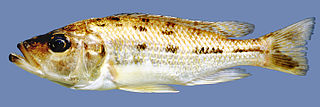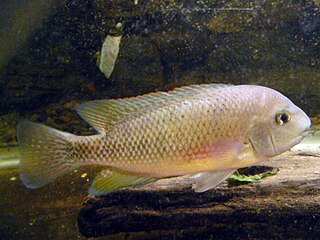
Cichlasoma is a genus of freshwater fish in the cichlid family. The genus was previously very large, including cichlids from North America, including Central America, and South America.
Paraneetroplus is a genus of cichlid fish native to moderately to fast-flowing waters in the Coatzacoalcos, Grijalva and Papaloapan river basins in southern Mexico. They reach up to 20–25.5 cm (8–10 in) in length.

Thorichthys is a genus of cichlid fish that is native to the Atlantic slope of Middle America, ranging from southern Veracruz and the Yucatán Peninsula in Mexico, to Guatemala and Honduras, with introduced populations in a few other countries. They tend to inhabit moderately-flowing to standing water such as rivers, streams, lakes, ditches and lagoons, and they are primarily freshwater fish, although T. helleri and T. meeki may occur in slightly brackish habitats.

Vieja is a genus of cichlid fish from Central America and Mexico. The majority of the species are freshwater fish found in stagnant or slow-moving waters of southern Mexico to El Salvador, but V. maculicauda, which also occurs in brackish waters, ranges south to Panama. They are high-bodied cichlids that reach lengths of up to 17–35 cm (7–14 in) depending on the exact species. Vieja feed mostly on vegetable matter, but may also take small invertebrates.

Archocentrus is a genus of cichlid fish from Central America. It currently contains a single species, the flier cichlid, which is found in stagnant and slow-moving freshwater habitats such as lakes, ponds, ditches, swamps and rivers in Honduras, Nicaragua and Costa Rica. It is up to 11 cm (4.3 in) long and feeds on invertebrates and detritus.

Herichthys is a small genus of cichlid fishes. Most are endemic to Mexico, but H. cyanoguttatus is also found in southern Texas, and has been introduced to central Texas and Florida. In 2015, the genus was split, and 7 species moved into Nosferatu.

Hemitaeniochromis urotaenia is a species of fish endemic to Lake Malawi in East Africa. It is the type species of the genus Hemitaeniochromis, and is part of family Cichlidae in subfamily Pseudocrenilabrinae and the tribe Haplochromini.

The Salvin's cichlid, also known as the yellow-belly cichlid or tricolored cichlid, is a species of the family Cichlidae. It is found in rivers of the Atlantic slope of southern Mexico, Belize, and Guatemala.
Tomocichla is a genus of cichlid fish native to moderately and fast-flowing rivers along the Atlantic slope of Central America, ranging from the Escondido drainage in Nicaragua to Bocas del Toro in Panama. Tomocichla was formerly included in Theraps and until 2015 Talamancaheros sieboldii was commonly included in Tomocichla. They are fairly large cichlids, up to 25–30 cm (10–12 in) in length.
Cryptoheros is a genus of small cichlid fishes from Central America and southeast Mexico. They reach up to 13 cm (5.1 in) in length.

Heroini is a fish tribe from the Cichlasomatinae subfamily in the cichlid family. All cichlids native to the Greater Antilles, United States, Mexico and northern Central America are members of this tribe. It also includes most cichlid species in southern Central America and several species from South America. A large percentage of its species were formerly placed in the genus Cichlasoma but have since been moved to other genera.

Maskaheros is a genus of cichlids fish found on Atlantic slope of southern Mexico and Guatemala in the Coatzacoalcos and Usumacinta River drainages. They are relatively large, high-bodied cichlids and were formerly included in the genus Paraneetroplus or Vieja.
Kihnichthys ufermanni, the Usumacinta cichlid, is a species of cichlid found in a few rivers in the Usumacinta River basin in Guatemala and southern Mexico. It typically occurs in rivers that are about 10–50 m (33–164 ft) wide, fairly deep, have few or no aquaritc plants, and a variable water current. This species is the only known member of its genus, but several of its features, including the chisel-like teeth, are shared with Cincelichthys and whether they should be merged into a single genus is not yet fully resolved; a review in 2020 recommended that the Usumacinta cichlid should be moved into Cincelichthys. The Usumacinta cichlid reaches a standard length of 25 cm (10 in).

Cincelichthys is a genus of high-bodied cichlids found in southern Mexico to Guatemala, where they inhabit lakes, rivers and other freshwater habitats. They are large cichlids, up to 35–42.5 cm (14–17 in) long depending on species, with females reaching smaller sizes than males.
Rheoheros is a genus of cichlids. These freshwater fish are found in the Atlantic slope of Mexico and Guatemala in moderately to fast-flowing waters of the Grijalva-Usumacinta River system. Depending on species, they reach up to 12–25 cm (4.5–10 in) in length.
The Montecristo cichlid is a species of freshwater fish from the Atlantic slope of southern Mexico and Guatemala. This cichlid occurs in lagoons, creeks and rivers with slight to moderate current in the Grijalva–Usumacinta, Candelaria, Champotón and Coatzacoalcos river drainages. It is currently recognized as the only species in its genus, but it is closely related to –and possibly should be merged into– Vieja. The Montecristo cichlid reaches up to 24 cm (9.4 in) in standard length.
Chiapaheros grammodes is a species of cichlid fish found in the upper part of the Grijalva River basin in southern Mexico and far western Guatemala. Adults generally inhabit areas with moderate to strong current, but they can also be found in backwaters and juveniles generally occur in calm waters. This species is the only known member of its genus, but historically it has been placed in several other genera. It reaches up to about 20 cm (8 in) in standard length. C. grammodes is relatively aggressive and quite predatory, tending towards piscivory. Both natural and aquarium hybrids have occurred between this species and Vieja hartwegi.
The bluemouth cichlid is a species of cichlid fish that is endemic to the Usumacinta River basin in southern Mexico and Guatemala, where it is widely distributed in rivers, creeks and lakes. This species is the only known member of its genus. The specific name honours the French cichlid specialist Jean Claude Nourissat (1942-2003), who collected type of this species. It reaches up to 22 cm (8.7 in) in total length.

Talamancaheros is a genus of cichlid fish found in fast- and moderately-flowing rivers on the Pacific slope of the Talamanca mountains of Costa Rica and western Panama. Talamancaheros reaches up to 25 cm (10 in) in standard length.

Chuco is a genus of medium-sized cichlid fishes from moderately to fast-flowing rivers and streams on the Atlantic slope of southern Mexico and northern Central America.












